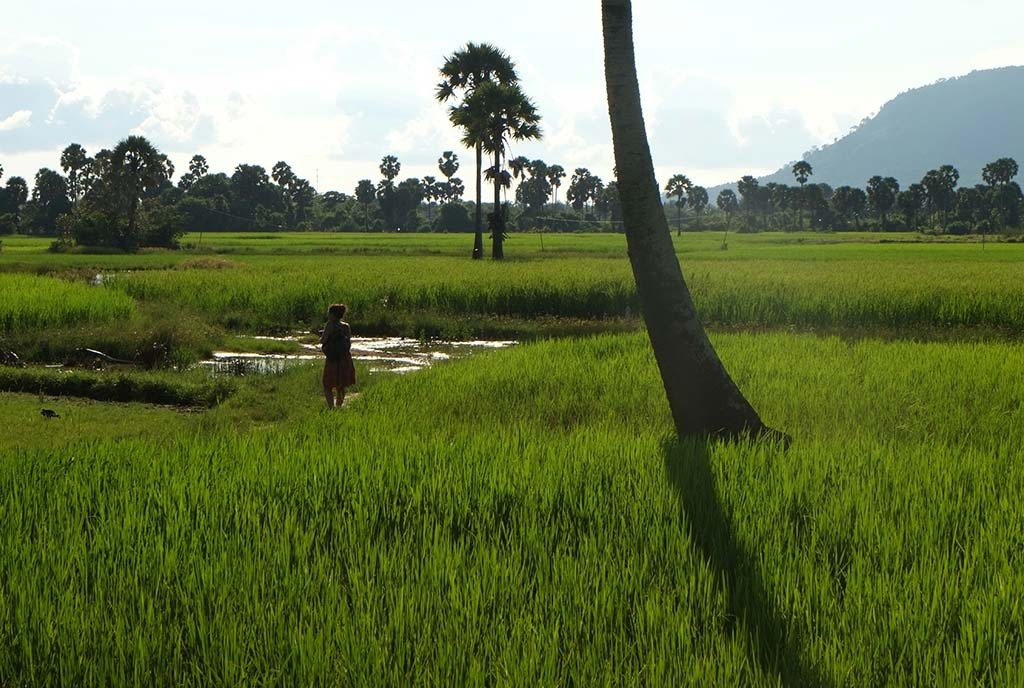
A staple food for over half of the world’s population faces many challenges. The sustainability of rice is threatened—and with it, the wellbeing of those who depend on it.
Traditional intensive rice monocultures, prevalent in many countries, are not only susceptible to climate change-induced disruptions but also contribute significantly to environmental degradation. However, an ancient yet underutilized practice offers a sustainable and eco-friendly alternative to contemporary farming practices.
Exploring Rice-Animal Co-Culture (RAC) Systems
Rice-animal co-culture (RAC) is an innovative and age-old agricultural practice that involves cultivating rice in paddies alongside various aquatic animals such as fish, shrimp, ducks, and crayfish. This symbiotic approach harnesses the synergies between rice crops and aquatic livestock.
A well-choreographed dance between farming and aquatic life, RAC benefits ecosystems and the communities they support. The presence of ducks in rice paddies serves as an ingenious pest management solution. With their voracious appetite for insects, ducks provide natural, chemical-free pest control, reducing the need for harmful pesticides. This ecological balance safeguards both the rice crop and aquatic life.
While foraging for insects, ducks also assist in weed control. Their paddling movements help churn the soil, disrupting weed growth and other unwanted vegetation. This not only benefits the rice plants but also creates a healthier environment for fish and crayfish.
Meanwhile, the incorporation of fish into rice paddies initiates a symbiotic relationship. Fish excreta is a natural fertilizer, enhancing the soil and providing essential nutrients for rice growth. This nutrient cycling, further enriched by the organic matter of ducks and crayfish, creates a dynamic ecosystem within the paddies. Integrating fish and crayfish into rice paddies diversifies the farm’s output by providing an additional source of protein and income for farmers while contributing to a more sustainable and economically viable farming model.
Another RAC benefit is that the shared use of water resources among rice, fish, ducks, and crayfish maximizes the efficiency of water use. Water circulates through the system, benefiting each component and reducing waste. This integrated approach minimizes the environmental footprint and optimizes the farm’s productivity.
Rice-duck and rice-crayfish co-culture systems also mitigate greenhouse gas emissions, thanks to oxygenating the water. Traditionally, rice is grown in flooded fields. Methane, a potent greenhouse gas, is naturally emitted during conventional rice farming as flooding a field cuts off its oxygen supply, which causes fermentation in organic matter in the soil. RAC systems can reduce methane emissions by about 40 percent compared to traditional rice monocultures.
Finally, the combined presence of fish, ducks, and crayfish promotes biodiversity, which not only contributes to a more robust and resilient ecosystem but also fosters a natural check-and-balance system, reducing the risk of diseases and pest outbreaks.
Economic Advantages
The economic benefits of RAC systems present a compelling case for farmers, with the potential to significantly enhance their earnings. A comprehensive study revealed that the average net income of farmers more than doubled from $1,019 US to $2,212 US per hectare annually after switching from conventional rice monoculture systems to RAC systems.
This substantial increase in income varied across different RAC systems. The composed system, a farming approach where multiple animal species are integrated, emerged as the most profitable, showing an impressive 393 percent increase, followed by the rice-crayfish system with a 197 percent increase, and the rice-fish system with a 98 percent increase. Even the rice-crab system, with the lowest percentage increase, demonstrated a 53 percent higher income than the traditional rice monoculture system.
Inspired by traditional practices of raising fish and rice together, FIF [sought] to create a sustainable alternative to threatened ocean forage fish.
It’s noteworthy that these income changes weren’t uniform globally. The increase ranged from $41 US per hectare in Nigeria to a substantial $1,451 US per hectare in China. These variations highlight the potential economic impact of RAC systems in diverse agricultural landscapes where baseline income levels can significantly differ.
Furthermore, RAC systems offer economic benefits through the production of higher-quality rice products and animal products. Products originating from RAC systems can apply for organic food certificates due to avoiding the use of mineral fertilizers and pesticides.
The value of organic certification is pivotal, as it allows products to command higher market prices. This is particularly relevant in the United States, where the demand for organic food has steadily grown, providing American farmers a unique opportunity to tap into this lucrative market.
Spotlight on Fish in the Fields Program
Fish in the Fields (FIF) is a pioneering development by the Resource Renewal Institute (RRI) that integrates the practice of rice-fish co-cultivation into modern agricultural practices. It stemmed from the Nigiri Project, an initiative to restore threatened native salmon populations in California’s winter-flooded rice fields.
The Nigiri Project demonstrated that these fields provided an abundant food source for salmon fingerlings—and laid the groundwork for FIF. Inspired by traditional practices of raising fish and rice together, FIF launched in 2012 to create a sustainable alternative to threatened ocean forage fish. The initial research project in California extensively investigated fish production, collaborating with farmers, managers, researchers, the California Department of Fish and Wildlife, and other stakeholders.
Sign up for our free newsletters
Subscribe to NPQ's newsletters to have our top stories delivered directly to your inbox.
By signing up, you agree to our privacy policy and terms of use, and to receive messages from NPQ and our partners.
According to RRI President Deborah Moskowitz, one of the project’s key funders, Patagonia, played a pivotal role by urging a deeper exploration of the methane pollution associated with rice cultivation.
The program is working to support vulnerable rice-growing communities by introducing two annual crops instead of one.
“The search for a solution led us to published research that documented the effect of small fish on methane emissions from a freshwater lake,” she said. “Applying this research to our rice field plots we made an unprecedented scientific discovery—adding fish to fallow flooded rice fields naturally and dramatically reduces methane in the water column.”
FIF made other positive discoveries, including that rice fields are 10 times more productive for raising fish than wild systems and require no additional expensive fish feed. Seasonally flooded landscapes supported biodiversity and facilitated wetland habitat connectivity, bird habitat, and fish passages.
Based on these findings, the California model is being adapted to a broader 140-acre pilot in Arkansas, the nation’s largest rice and fish producer. This expansion signifies the program’s scalability and adaptability.
Fish in the Fields, and Justice
FIF also plays a pivotal role in mitigating the direct effects of the climate crisis and fostering economic diversity. The program is working to support vulnerable rice-growing communities by introducing two annual crops instead of one.
To address social justice disparities, FIF also envisions the development of a protocol for rice agriculture that will be incorporated into USDA’s (United States Department of Agriculture) best practices and policies. Underrepresented farmers are actively invited to participate in and contribute to FIF’s development through outreach activities, conferences, and field days. Collaborations with organizations like the National Black Growers Council, Warehouses4Good, and the Arkansas River Rice Mill also highlight a commitment to inclusivity.
Wider adoption of FIF promises greater economic support for rural communities. By transforming US rice cultivation from a monocultural and seasonal practice to a year-round employment opportunity, FIF aims to bring stability and security to farm families with minimal modification and potential downstream benefits, including carbon credits and lower fertilizer costs.
Beyond economic benefits, FIF also holds the promise of enhancing the quality of life for rural communities by sustaining and expanding winter flooding. This could contribute to ecosystem restoration, improved water management, and air quality. In regions where natural wetlands have been lost to agriculture, rice water gains a second life downstream, replenishing rivers and streams that support fish runs and other habitats.
Global Relevance and Future Implications
In a world grappling with a surging population and in the throes of climate change, the imperative for sustainable food production has never been more vital.
RAC systems, exemplified by initiatives like Fish in the Fields, play a pivotal role in addressing the global need for sustainable food production. With nearly three million acres dedicated to rice cultivation in the United States alone, integrating fish and other aquatic species would enhance agricultural productivity. By diversifying food sources and increasing yields per unit area, RAC systems contribute directly to Sustainable Development Goal 2 (SDG2): Zero Hunger, an initiative from the United Nations.
Furthermore, RAC systems positively impact environmental sustainability, aligning with multiple SDGs and contribute to SDG13 (Climate Action) by reducing methane emissions.
RAC systems hold promising implications for the future of global agriculture and sustainability. The success of initiatives like FIF provides a blueprint for incorporating nature-based solutions into mainstream agricultural practices. As Chance Cutrano, the director of programs at RRI, said, “With a clear USDA protocol based on sound science, I believe more farmers will be open to experimentation with rice-fish production systems, and more investment will enter the space.”
The success and recognition garnered by initiatives like FIF also underscore the role of philanthropy and collaboration in advancing sustainable agriculture. For instance, the 2023 J.M.K. Innovation Prize the program received provides funding and heightened visibility for the project. This recognition can advance further collaborations, research, and the development of best practices, ultimately contributing to the widespread adoption of RAC systems.
The urgency of understanding and promoting practices like RAC systems cannot be overstated, considering how these practices offer a holistic approach to environmental conservation, food security, and climate resilience. In a world grappling with a surging population and in the throes of climate change, the imperative for sustainable food production has never been more vital.











